Ancasta Race Boats
Find out more
Race Boat listings
See our listings

The home of racing yacht sales
Full listing database
Race Boats for Sale, News & Advice
With over 25 years of experience specialising in performance sail boats ranging from 25 to 100ft, Ancasta Race Boats will be able to guide you through the sale or purchase of any racing yacht.
We are the market leaders with an in depth knowledge of the various rating rules operating around the globe, as well as extensive inshore and offshore experience amongst the team, we are able to confidently discuss the options available to you, as well as scanning the market to find those unknown “offline” listings.
With offices in the UK, USA and Spain, Ancasta Race Boats really have a global outreach and their finger firmly on the racing scene’s pulse and have conducted close to $100m worth of sales since its inception.
Selling a race boat?
sell my boat
View All Used Performance Race Boat Listings
J/boats j/112e.
J/Boats J/112e - Ref 38674 has been saved to your account.
Your account cannot save boats.
Beneteau First 18
Beneteau First 18 - Ref 37770 has been saved to your account.
Mills 39 - Ref 43465 has been saved to your account.
Class 40 VPLP Clak 40
Class 40 VPLP Clak 40 - Ref 40751 has been saved to your account.
ORC 37 - Ref 43710 has been saved to your account.
J Boats J122
J Boats J122 - Ref 33926 has been saved to your account.
J/V PCT 74 - Ref 40726 has been saved to your account.
TP / IRC 52 Botin
TP / IRC 52 Botin - Ref 43804 has been saved to your account.
JND 39 - Ref 42915 has been saved to your account.
One Design Cape 31
One Design Cape 31 - Ref 43411 has been saved to your account.
Soto 65 - Ref 33537 has been saved to your account.
Beneteau First 44
Beneteau First 44 - Ref 42514 has been saved to your account.
J/Boats J/112e - Ref 42983 has been saved to your account.
DNA F4 Foiling Cat
DNA F4 Foiling Cat - Ref 35143 has been saved to your account.
Race News View All
Ac40 – first private build slot confirmed, ancasta collection magazine – #30 out now, ac40 simulator at metstrade, first ac40 regattas a success, customer handover – protector chase 310, ancasta collection magazine – issue 29, the admiral’s cup returns, the ancasta collection magazine 28th edition, 37th america’s cup ac40 preliminary regattas, race events view all, british motor yacht show 2024, motorboat club cruise 2024 yarmouth – guernsey, ac40 - learn to fly view all, ac40 - preliminary regatta jeddah, ac40 - ownership, ac40 - what does what, introducing the new ac40, ac40 takes off in new zealand, mcconaghy boats help gear up for the 37th america’s cup, race features & articles view all, q&a with chase boat skipper for emirates gbr sailgp team, alan roberts racing, la solitaire urgo le figaro 50th anniversary, harken at the front, la solitaire urgo le figaro, cruiser racer guide, top tips - sailing fitness, the development of foiling sailboats, racing tips - the fundamentals of good crew work, racing tips - downwind trimming, racing tips - upwind trimming, race videos.
View All Used Cruiser Race Boat Listings
Sweden yachts 390.
Sweden Yachts 390 - Ref 43080 has been saved to your account.
Camper & Nicholsons 60 Riviera
Camper & Nicholsons 60 Riviera - Ref 29451 has been saved to your account.
Island Packet 32
Island Packet 32 - Ref 35890 has been saved to your account.
Beneteau Oceanis 343
Beneteau Oceanis 343 - Ref 30476 has been saved to your account.
Beneteau Oceanis 473
Beneteau Oceanis 473 - Ref 17176 has been saved to your account.
North Wind 47
North Wind 47 - Ref 42554 has been saved to your account.
Amel 55 - Ref 44164 has been saved to your account.
Jeanneau 64
Jeanneau 64 - Ref 36698 has been saved to your account.
Bavaria 42 - Ref 43125 has been saved to your account.
Amel 54 - Ref 44160 has been saved to your account.
Oyster 55 - Ref 44095 has been saved to your account.
STARLIGHT 35
STARLIGHT 35 - Ref 44053 has been saved to your account.
Bavaria 33 Cruiser
Bavaria 33 Cruiser - Ref 44011 has been saved to your account.
Bavaria 33 Cruiser - Ref 43538 has been saved to your account.
Race Boat Dealer For
Myancasta sign in, buying and selling a boat is smooth sailing with a myancasta account..
- Access VIP offers
- Stay informed about the latest news & events
- Get notified of new boat listings
- Save your favourite boat listings
- Create personalised boat searches
- Contribute to the HUB Forum
- Control your data
Looking for a chase boat?
Protector Boats are among the most capable and durable utility vessels in the world
Find Out More
HOW TO SELL YOUR RACE BOAT
GUIDES AND ADVICE
Why sell with Ancasta?
How to sell a boat – a comprehensive guide, why should i use a yacht broker to sell my boat, how to sell your multihull with ancasta, how do i prepare my boat for sale.
HOW TO SELL YOUR BOAT
HOW TO BUY A RACE BOAT
Is a marine survey important, why use a professional yacht broker to buy a boat, buying a boat – a comprehensive guide.
HOW TO BUY A BOAT
Lost Password?
Don't have an account? Register
Make buying and selling a boat smooth sailing with your FREE MyAncasta account.
Sign in Register
Privacy Overview

request a call from francis shiman-hackett I am available and happy to answer any questions

Email francis shiman-hackett I am available and happy to answer any questions

- P: 401.855.4355 | E: [email protected]

- Sell Your Boat
- Featured Listings
- Brokerage Yachts
- Performance Yacht Sales
- Jeanneau Yachts
- Pegasus Yachts
- Saffier Yachts
- Excess Catamarans
- Race Charters
- Charter Availability
- First Time Ownership Programs
- Available Charter Boats
- Fractional Ownership
- Glenn Walters
- Richard Barker
- Francis Shiman-Hackett
- Steve Fischer
- Kate Haines
- Ryan Murphy
- Jonathan Banks
- Testimonials
- Charter Ownership Programs
- Service/Parts
- Sailing School

Racing Sailboats
Search by make.
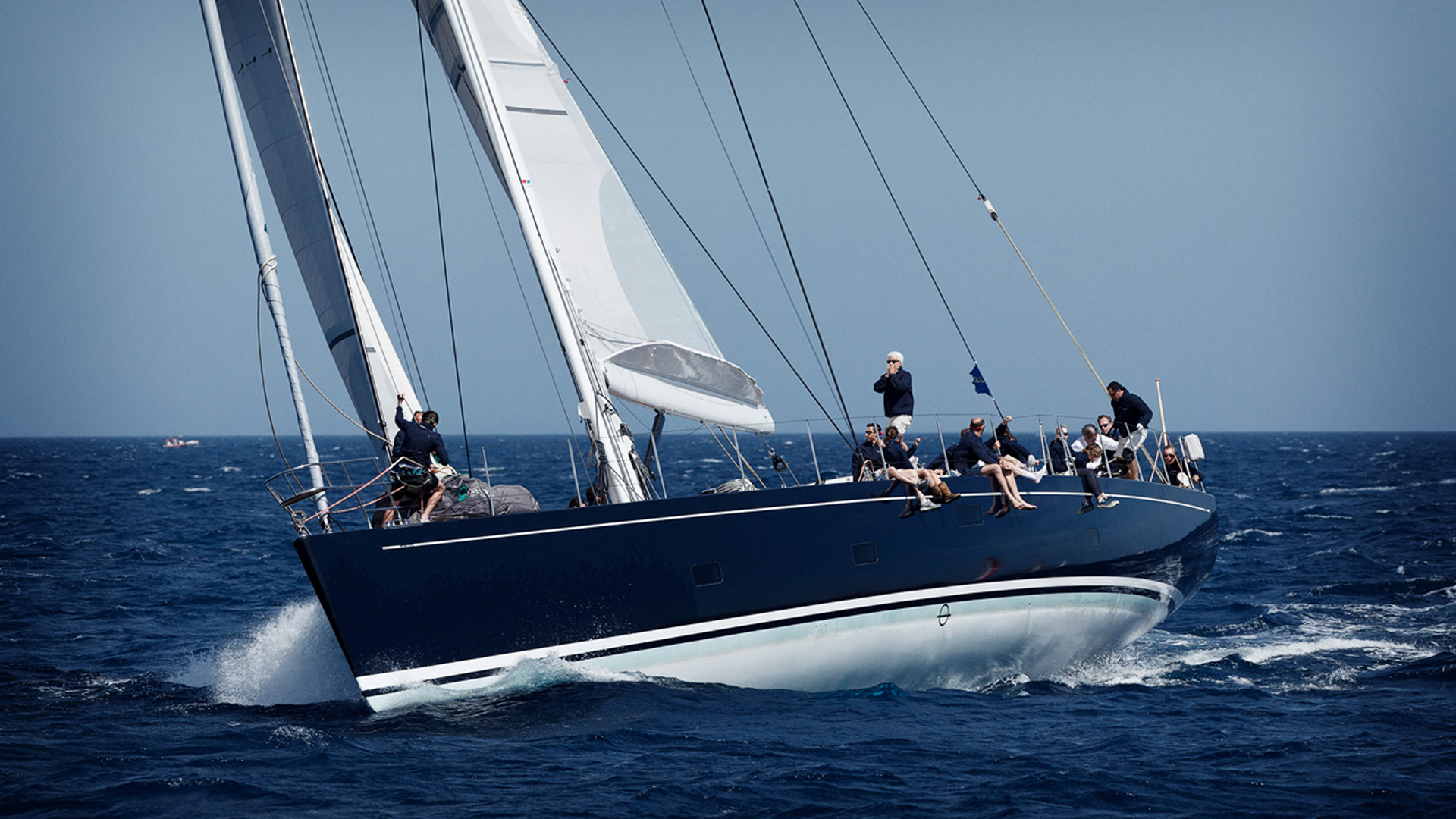
Three FREE Boat Suggestions!
Our clients find this questionnaire will clarify and facilitate your next purchase for an easier, efficient, and less time consuming process.
After you submit the questionnaire we will send you three boat ideas that best fit your inputs for your review.
The questionnaire and the three boat suggestions are at no charge or obligation.
We are committed to a successful, positive experience when purchasing your next used or new boat at the right price and best fit for your intended use and needs.
Sincerely Glenn Walters Managing Partner
Our clients find this questionnaire will clarify and facilitate your next purchase for an easier, efficient, and less time consuming process. After you submit the questionnaire we will send you three boat ideas that best fit your inputs for your review. The questionnaire and the three boat suggestions are at no charge or obligation.
This website uses cookies . This allows us to offer you the necessary functionalities and also improve your user experience. If you visit our website, you agree to the cookie statement
Yachts For Sale
Can't find what you are looking for? Please SEND US YOUR WISHLIST and our agents will link you to your perfect yacht!
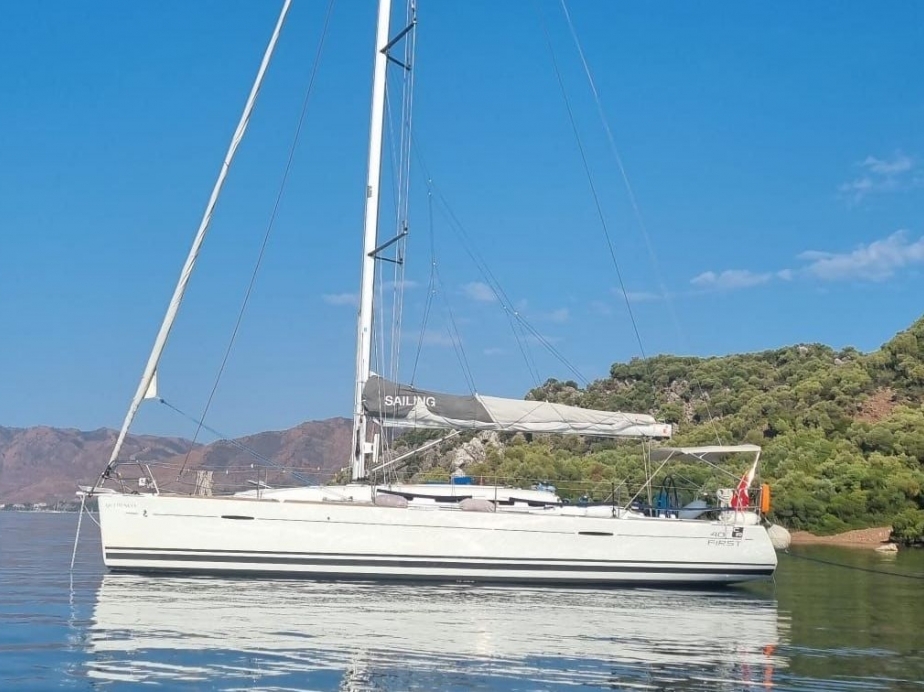
- Builder / Designer : Beneteau
- : Farr Yacht Design
- L.O.A. (mtr): 12.26
- Displacement (Kg): 7500
- Location: Turkey
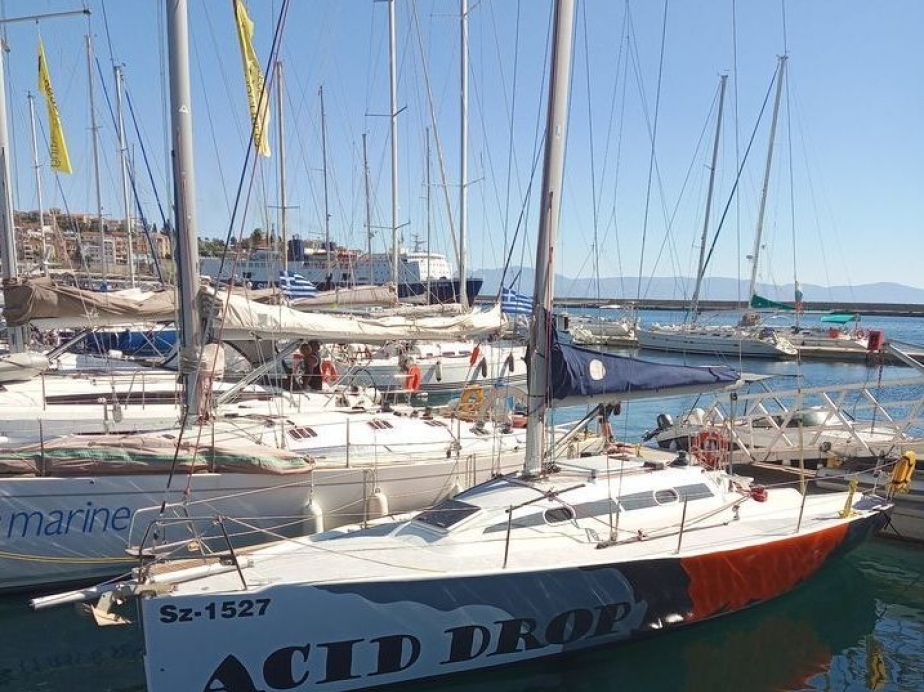
- Builder / Designer : Fiumanka
- L.O.A. (mtr): 9.90
- Location: Greece
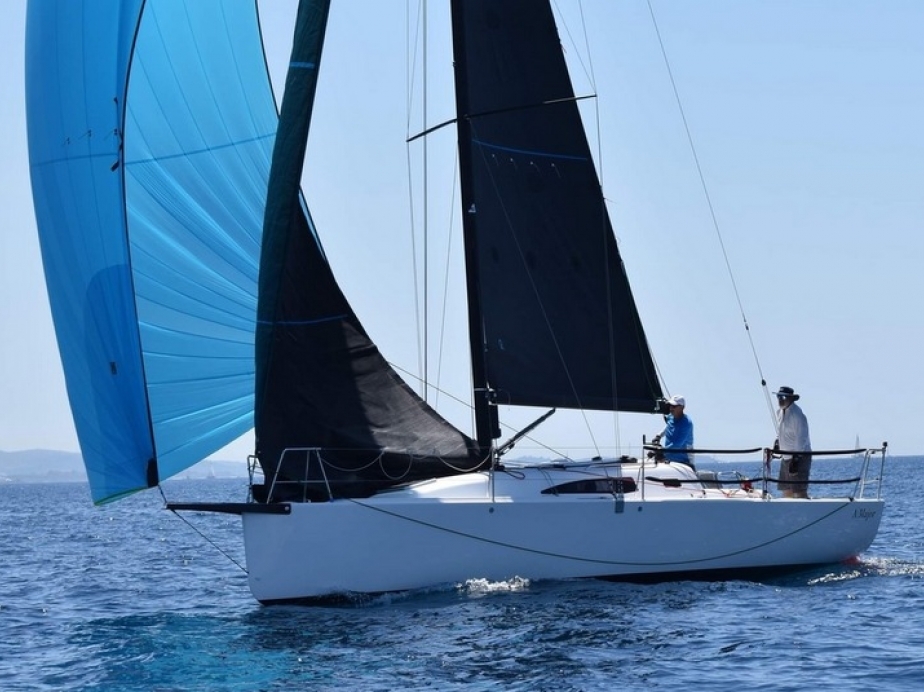
- Builder / Designer : J Boats
- L.O.A. (mtr): 9.94
- Displacement (Kg): 3800
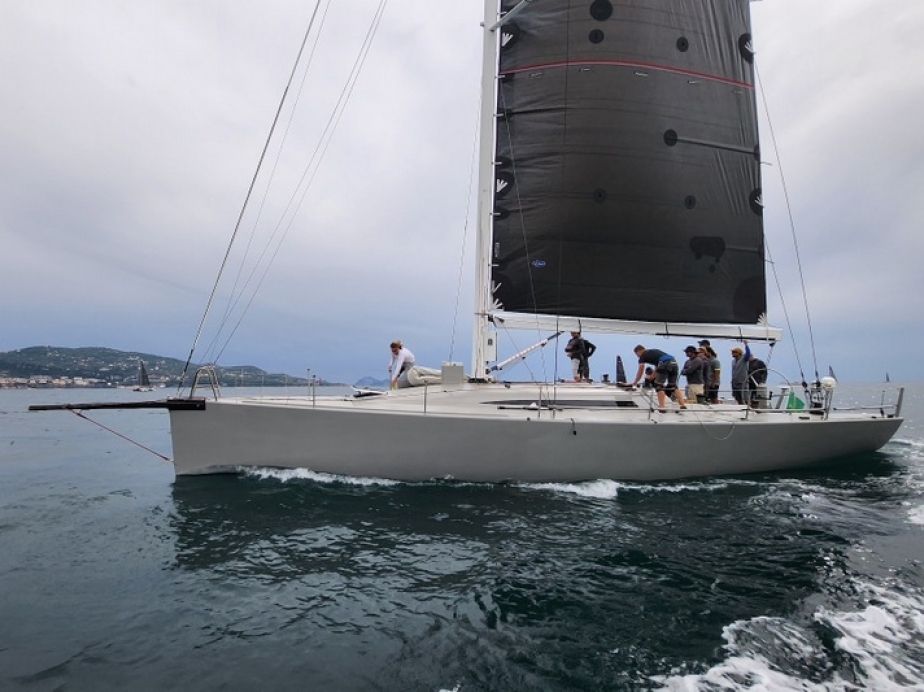
- Builder / Designer : Cookson
- L.O.A. (mtr): 15.22
- Displacement (Kg): 7400
- Location: Italy
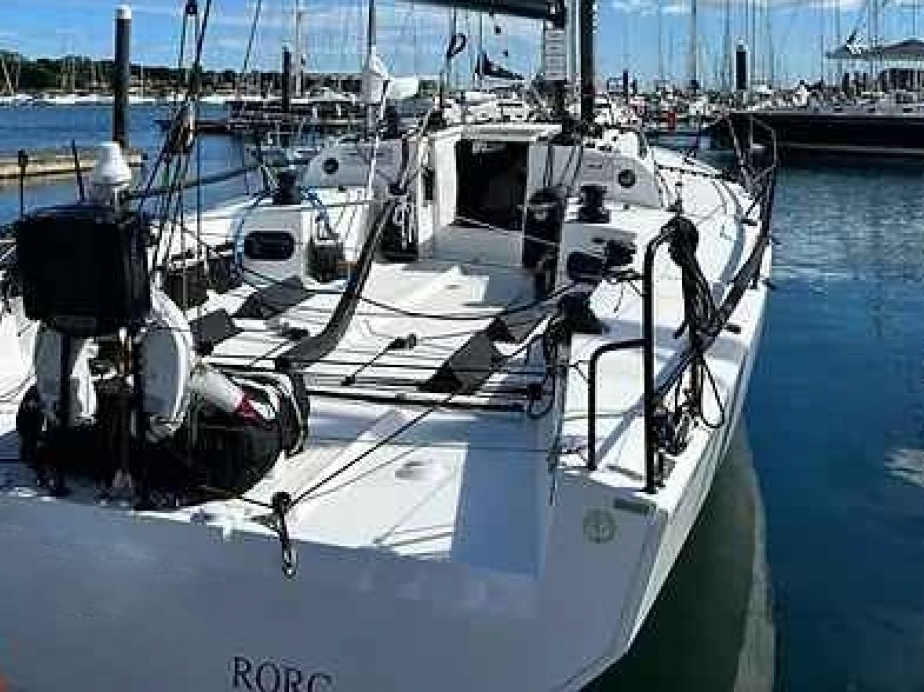
- Builder / Designer : JPK
- : Jacques Valer
- L.O.A. (mtr): 11.80
- Displacement (Kg): 6100
- Location: United Kingdom
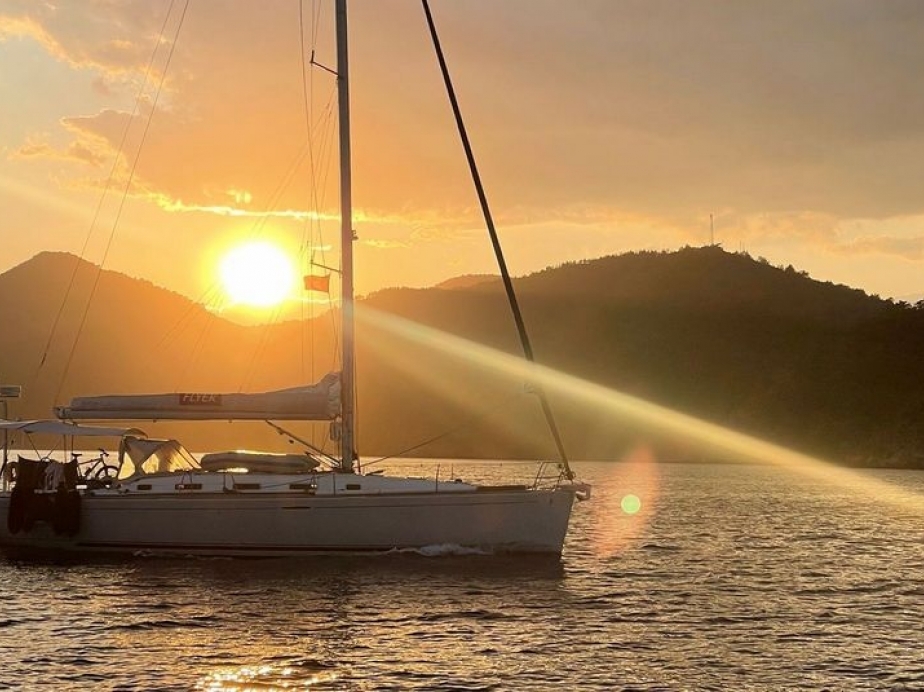
- Builder / Designer : X-yachts
- : X-Yachts design team
- L.O.A. (mtr): 12.50
- Location: Netherlands
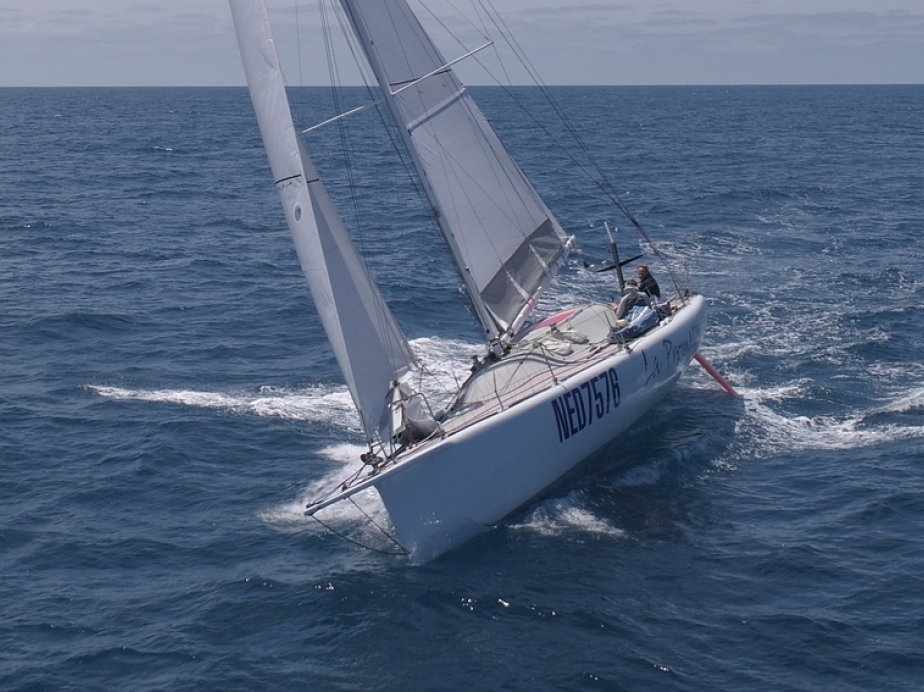
- Builder / Designer : Open
- : Phil Morrison
- L.O.A. (mtr): 12.10
- Displacement (Kg): 3600
- Location: Belgium
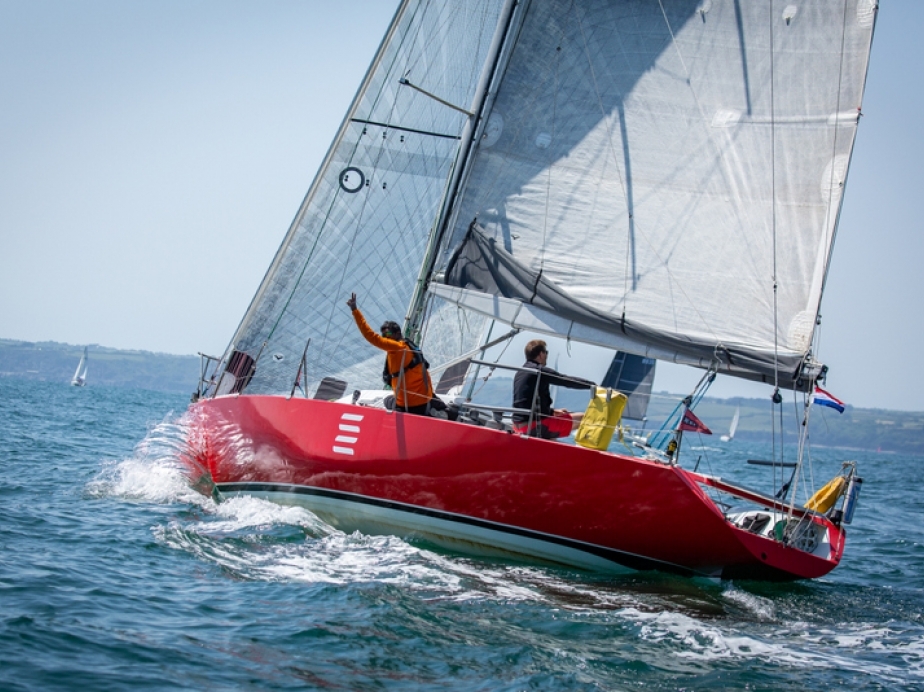
- Builder / Designer : Judel Vrolijk
- : Judel and Vrolijk
- L.O.A. (mtr): 12.00

Types of Racing Sailboats

Last Updated by
Jacob Collier
August 30, 2022
Sailboats come in many different shapes and sizes depending on a variety of factors. This means there are a variety of sailboat racing boat types on the market.
When you look specifically at racing sailboats, you will notice several different aspects that separate them from other sailboats. You might be wondering, what are the types of racing sailboats?
There are many types of racing sailboats that range from one-man dinghies all the way to 100-foot yachts. Some racing sailboats are classified as keel boats, multi-hull, and even a tower ship. These boats are built primarily for speed, so comfort is usually an afterthought depending on the brand.
For racing sailboats, each one is going to fit within a specific race category. So depending on the type of race will dictate the types of sailboats you will see.
According to sailboat data, racing boats have slightly different designs that stand out compared to bluewater sailboats. Looking at the Olympics is another example of what other racing sailboats are out there.
Table of contents
Characteristics of Racing Sailboats
There are quite a few sailboats made today that are geared specifically towards racing. They have one purpose, which is to go as fast as possible.
Some racing sailboats are advanced far more than the average ones, which is completely up to the buyer. For example, America’s Cup race showcases “foiling boats” that run on foils under the hulls. These allow the sailboats to go faster than 50 MPH.
If you are searching for boats that have characteristics to fit within a specific race type, you will find that many boats can enter different races depending on the rules. The most popular sailboat races are:
- Offshore/Oceanic
There are key features that separate racing boats from other sailboats and allow them to enter specific races. These can be narrowed down to the hull design, the type of keel, how many masts it has, and what type of sails are used.
Size of Racing Sailboats
As mentioned, these boats range from smaller dinghies to 100-foot yachts. Depending on the type of race will determine the type of boat that is being used.
The size of certain boats might prevent them from entering races where only smaller ones are allowed. There are exceptions in some races, like a handicapped fleet race, that will adjust the rating to allow their final time to be adjusted. The reason some races are handicapped to a certain extent is so a captain and his crew can determine the outcome and not a boat that is at an advantage.
Overall Design
With racing sailboats, they are subject to racing against the wind about half of the time. The angles of the boats are still similar to cruisers but greatly differ in the size of the sails to allow the sheets to have a better shape.
As racing boats are typically trying to sheet the sails hard, they are trying to keep them within the centerline. This allows the sails to be flatter and change them as needed.
Over time, the sails will typically wear out faster than the ones being used on regular sailboats. Since they are aggressively being used to stretch in the wind, they are subject to more use than regular sailboats.
Similar Looking Sailboats
There are races that only accept sailboats called one-design. These sailboats are built to exact specifications and are nearly identical to one another.
The reason that these boats are designed is to help combat any potential advantages from one boat to the next. It does not really set itself apart from other boats, but it is a good start to get into racing.
Lack of Interior Accommodations
Racing sailboats typically lack anything special on the inside to help save weight and go faster. Since a lot of features are not available, this means it would be nearly impossible to liveaboard full time.
In most scenarios, a true racing sailboat strictly has one purpose: to go fast. This does not mean that all racing sailboats cannot have luxury or comfort, since boat racing has been in existence since boats were first invented for water.
You would need to find boats that have a great balance between using them on weekends and racing. There are plenty of options to consider for what you want to accomplish in racing and comfort.
Types of Sails Being Used
Another characteristic that separates racing boats from cruisers is the types of sails that are being used. Both are designed for performance but are measured a bit differently. Racing sails are meant for speed, as regular sails are meant for cruising.
Depending on the goal of sailing, such as racing, you could look into purchasing sails that are specific to racing. Would you rather take off an extra minute or two of your time with a long upwind leg during a race or have the same durable sail for another five years out?
This opens up the door to endless possibilities of sail-making materials to get the job done. Most cruisers use Dacron or laminates that use a high-stretch fiber. With racing boats, light laminate sails have proven to be more durable and last longer than previous racing sails.
Popular Types of Racing Sailboats
Since the goal is to be around 50 MPH and have the best handling, many options have to be considered for the type of boat to possess both. Since comfort is not a deciding factor, it is somewhat easier to narrow down a racing boat over a bluewater or cruiser boat.
The types of racing sailboats that cater to you will all depend on your budget and your main goal of use. Each series of boats has its main purpose, with some having a little bit of comfort with racing.
Yachts and Super-Sized Sailboats
Yachts that specialize in racing tend to have a solid mix between speed and comfort. With a fiberglass hull and roughly 50 feet or so in length, these boats are not easily handled by just one or two people like others or there.
With that being said, they are also the most expensive out of the group. Even with exceptionally older models, you are still easily looking at $100,000.
You can expect to see racing yacht sailboats to reach about 17 MPH. Depending on the size, they can go faster or slower.
High-Performance Cruisers
Some boats can do it all when it comes to all-around performance . If you are looking for a boat that you can race for fun but still want to take it out offshore and live on, then you need to look at high-performance cruisers that can do both.
These boats generally range between 25 to 40 feet and are similar to yachts. However, they do not have as much luxury in comparison but the price tag is not nearly as heavy.
Trailerable Sailboats
Trailerable sailboats fall into similar categories like the dinghy and small racing boats. These boats can range in length up to 27 feet but are limited in their height and weight.
These serve a purpose for just about anything to do with sailing, but the racing ones are strictly for racing. Their design is meant for speed, not the comfort of heavy-duty performance offshore.
Small Racing Sailboats
Smaller racing sailboats are built to be lighter and have practically nothing on board compared to cruisers or dinghies. Due to their smaller size, they often get mistaken for larger dinghies even though they typically range between 20 and 70 feet.
These smaller racing sailboats are related to cruising sailboats but are a bit smaller. They are cousins to sailing dinghy boats that are used for racing. They also have fin keels and utilize laminate sails.
Sailing Dinghies
Dinghies are a category of small boats that have a wide variety of uses. If you are new to boating, it is a great place to start learning due to its size and simplicity.
These typically only need one or two people at most and are no longer than 15 feet in length at max. Many of these boats are competitively raced and will also result in a wet ride no matter what you do. You will see these types of boats used in certain Olympic events.
Racing Cruising Sailboats
Cruisers have a wide range in size and length, as they range between 16 and 50 feet or more. They feature cabins for extended cruising and have standing headroom below deck if over 26 feet.
Popular brands on the market have introduced models that are fit for racing. These are great for fleet races or for boats that are associated with cruising. With that being said, it is a great compromise for boaters that enjoy racing but also want to cruise whenever they want.
The cutter features a single mast and mainsail, which is very similar to common sailboats like a sloop. A cutter sailboat has the mast further aft which allows the attachment of the jib and staysail.
In high winds, a smaller staysail can still be flown from the inner stay. This used to be a traditional racing design back in the day.
Cutters are great for both offshore and coastal cruising. In addition, they can still be utilized as a racing boat depending on the conditions.
Fractional Rig Sloop
Fractional rig sloop sailboats were popular in the 60s and 70s, but have steadily made a comeback in today's market. This sloop’s forestay will not cross at the highest point of the mast, meaning it attaches at a lower position.
On fairly windy days when you do not have to utilize full power, the fractional rig allows the crew to slightly bend the tops of the mast and flatten out sails. This greatly affects performance and is a great option for cruising, one-design races, and even handicap sailing.
Schooner Sailboats
These particular sailboats have multiple sails which are protected by two masts. These are known as the mainmast and foremast, with the foremast being close to the ship’s foredeck and a lot shorter than the mainmast.
Depending on the size of the schooner, additional masts can be added to allow more sails. These are great for offshore cruising and sailing but can be an effective racing boat.
Trimarans and Catamarans
Trimarans have three of their hulls side by side and “cats” only have two. In comparison, they both share very similar characteristics for racing and overall performance.
Trimarans are quicker and easier to build than catamarans, so, therefore, they are more common. They both have similar restrictions on space and can be used for day sailing.
In addition, they are not as stable as compared to other sailboats out there. There are still various ways to use them and they make for great racing boats since they can reach up to 10 MPH.
How Can These Boats Go Faster?
Each person will select a racing boat that fits their needs accordingly. If you enjoy racing, but continue to lose against boats that are the same, you might want to consider either your team, the technique behind it all, or the boat itself. Routine maintenance is going to be the best thing you can do when checking to see if your racing sailboat can go any faster.
The hull has to be in top shape and needs to be able to hold tension. The sails also need to be checked to make sure they are not overly stretched or worn out.
The masts also need to be of the right stiffness, as they are bending with tension from the rigging. This one might have to be professionally calibrated if you do not know how to do it, especially since every boat with its mast is going to measure differently based on size and shape.
Finally, the weight of the boat could be the determining factor in winning or losing. Make sure the weight is appropriate and the maximum amount for the boat is not exceeded.
Related Articles
Types of Sailboats: A Complete Guide
Born into a family of sailing enthusiasts, words like “ballast” and “jibing” were often a part of dinner conversations. These days Jacob sails a Hallberg-Rassy 44, having covered almost 6000 NM. While he’s made several voyages, his favorite one is the trip from California to Hawaii as it was his first fully independent voyage.
by this author
Best Sailboats

Most Recent

Affordable Sailboats You Can Build at Home
Daniel Wade
September 13, 2023

Best Small Sailboats With Standing Headroom
December 28, 2023
Important Legal Info
Lifeofsailing.com is a participant in the Amazon Services LLC Associates Program, an affiliate advertising program designed to provide a means for sites to earn advertising fees by advertising and linking to Amazon. This site also participates in other affiliate programs and is compensated for referring traffic and business to these companies.
Similar Posts

Best Bluewater Sailboats Under $50K

Best Blue Water Sailboats Under 40 Feet

Which Sailboats Have Lead Keels?
June 20, 2023
Popular Posts

Best Liveaboard Catamaran Sailboats

Can a Novice Sail Around the World?
Elizabeth O'Malley
June 15, 2022

4 Best Electric Outboard Motors

How Long Did It Take The Vikings To Sail To England?

10 Best Sailboat Brands (And Why)
December 20, 2023

7 Best Places To Liveaboard A Sailboat
Get the best sailing content.
Top Rated Posts
Lifeofsailing.com is a participant in the Amazon Services LLC Associates Program, an affiliate advertising program designed to provide a means for sites to earn advertising fees by advertising and linking to Amazon. This site also participates in other affiliate programs and is compensated for referring traffic and business to these companies. (866) 342-SAIL
© 2024 Life of Sailing Email: [email protected] Address: 11816 Inwood Rd #3024 Dallas, TX 75244 Disclaimer Privacy Policy
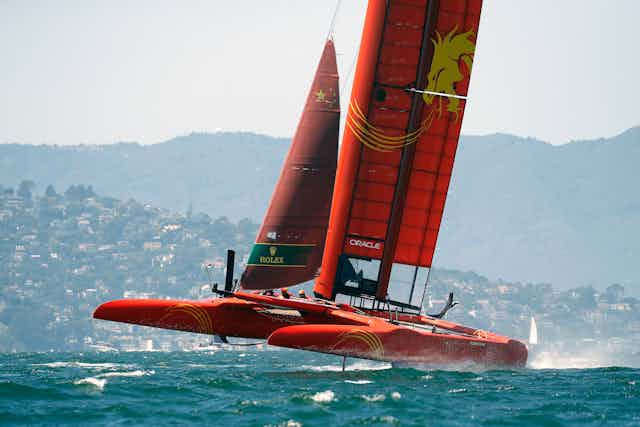
Sail GP: how do supercharged racing yachts go so fast? An engineer explains
Head of Engineering, Warsash School of Maritime Science and Engineering, Solent University
Disclosure statement
Jonathan Ridley does not work for, consult, own shares in or receive funding from any company or organisation that would benefit from this article, and has disclosed no relevant affiliations beyond their academic appointment.
View all partners
Sailing used to be considered as a rather sedate pastime. But in the past few years, the world of yacht racing has been revolutionised by the arrival of hydrofoil-supported catamarans, known as “foilers”. These vessels, more akin to high-performance aircraft than yachts, combine the laws of aerodynamics and hydrodynamics to create vessels capable of speeds of up to 50 knots, which is far faster than the wind propelling them.
An F50 catamaran preparing for the Sail GP series recently even broke this barrier, reaching an incredible speed of 50.22 knots (57.8mph) purely powered by the wind. This was achieved in a wind of just 19.3 knots (22.2mph). F50s are 15-metre-long, 8.8-metre-wide hydrofoil catamarans propelled by rigid sails and capable of such astounding speeds that Sail GP has been called the “ Formula One of sailing ”. How are these yachts able to go so fast? The answer lies in some simple fluid dynamics.
As a vessel’s hull moves through the water, there are two primary physical mechanisms that create drag and slow the vessel down. To build a faster boat you have to find ways to overcome the drag force.
The first mechanism is friction. As the water flows past the hull, a microscopic layer of water is effectively attached to the hull and is pulled along with the yacht. A second layer of water then attaches to the first layer, and the sliding or shearing between them creates friction.
On the outside of this is a third layer, which slides over the inner layers creating more friction, and so on. Together, these layers are known as the boundary layer – and it’s the shearing of the boundary layer’s molecules against each other that creates frictional drag.
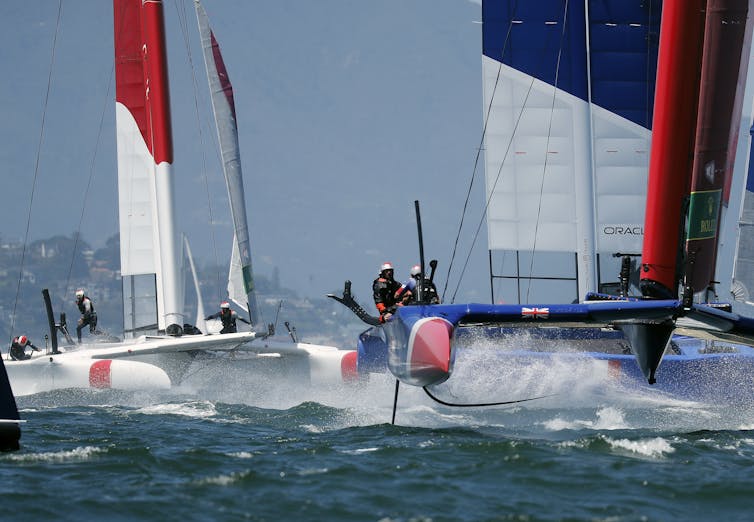
A yacht also makes waves as it pushes the water around and under the hull from the bow (front) to the stern (back) of the boat. The waves form two distinctive patterns around the yacht (one at each end), known as Kelvin Wave patterns.
These waves, which move at the same speed as the yacht, are very energetic. This creates drag on the boat known as the wave-making drag, which is responsible for around 90% of the total drag. As the yacht accelerates to faster speeds (close to the “hull speed”, explained later), these waves get higher and longer.
These two effects combine to produce a phenomenon known as “ hull speed ”, which is the fastest the boat can travel – and in conventional single-hull yachts it is very slow. A single-hull yacht of the same size as the F50 has a hull speed of around 12 mph.
However, it’s possible to reduce both the frictional and wave-making drag and overcome this hull-speed limit by building a yacht with hydrofoils . Hydrofoils are small, underwater wings. These act in the same way as an aircraft wing, creating a lift force which acts against gravity, lifting our yacht upwards so that the hull is clear of the water.

While an aircraft’s wings are very large, the high density of water compared to air means that we only need very small hydrofoils to produce a lot of the important lift force. A hydrofoil just the size of three A3 sheets of paper, when moving at just 10 mph, can produce enough lift to pick up a large person.
This significantly reduces the surface area and the volume of the boat that is underwater, which cuts the frictional drag and the wave-making drag, respectively. The combined effect is a reduction in the overall drag to a fraction of its original amount, so that the yacht is capable of sailing much faster than it could without hydrofoils.
The other innovation that helps boost the speed of racing yachts is the use of rigid sails . The power available from traditional sails to drive the boat forward is relatively small, limited by the fact that the sail’s forces have to act in equilibrium with a range of other forces, and that fabric sails do not make an ideal shape for creating power. Rigid sails, which are very similar in design to an aircraft wing, form a much more efficient shape than traditional sails, effectively giving the yacht a larger engine and more power.
As the yacht accelerates from the driving force of these sails, it experiences what is known as “ apparent wind ”. Imagine a completely calm day, with no wind. As you walk, you experience a breeze in your face at the same speed that you are walking. If there was a wind blowing too, you would feel a mixture of the real (or “true” wind) and the breeze you have generated.
The two together form the apparent wind, which can be faster than the true wind. If there is enough true wind combined with this apparent wind, then significant force and power can be generated from the sail to propel the yacht, so it can easily sail faster than the wind speed itself.
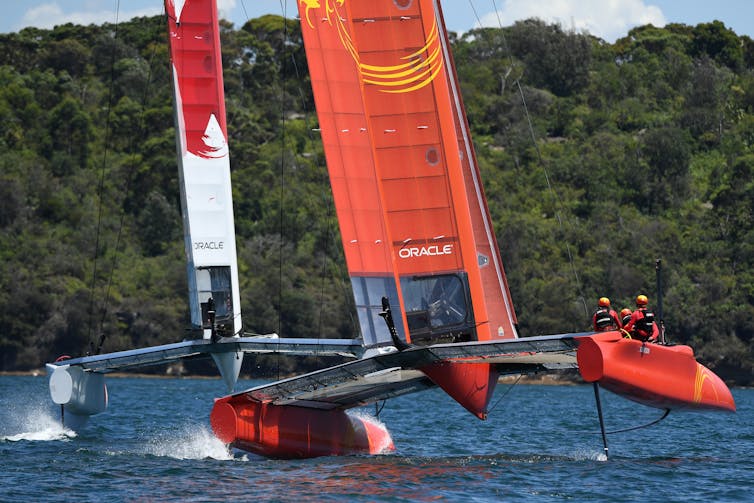
The combined effect of reducing the drag and increasing the driving power results in a yacht that is far faster than those of even a few years ago. But all of this would not be possible without one further advance: materials. In order to be able to “fly”, the yacht must have a low mass, and the hydrofoil itself must be very strong. To achieve the required mass, strength and rigidity using traditional boat-building materials such as wood or aluminium would be very difficult.
This is where modern advanced composite materials such as carbon fibre come in. Production techniques optimising weight, rigidity and strength allow the production of structures that are strong and light enough to produce incredible yachts like the F50.
The engineers who design these high-performance boats (known as naval architects ) are always looking to use new materials and science to get an optimum design. In theory, the F50 should be able to go even faster.
- Engineering
- Aerodynamics

Lecturer / Senior Lecturer - Marketing

Communications and Engagement Officer, Corporate Finance Property and Sustainability

Assistant Editor - 1 year cadetship

Executive Dean, Faculty of Health

Lecturer/Senior Lecturer, Earth System Science (School of Science)
Yachting World
- Digital Edition

America’s Cup boats: How they work and why they’re unique
- Toby Heppell
- February 5, 2021
The America's Cup boats to be used on the 2021 edition of the event are unlike anything we have seen before. They might be officially sailing craft but they behave in some remarkable ways.

The AC75s, the America’s Cup boats currently racing in the Prada Cup and that will be used for next month’s Cup match showdown, are arguably the most radical boat the America’s Cup has ever seen.
The America’s Cup is, fundamentally, a design competition, and successive America’s Cups have featured the most extreme yachts yet – for their time – ever since the first race in 1851 .
However, the foiling boats we have seen in the last three editions of America’s Cup racing (the AC72 and AC50 catamarans, and now the AC75 monohulls ) do represent a new direction for the highest level of sailing.
There are plenty who argue that this technology is so far beyond the bounds of what most people consider sailing as to be an entirely different sport. Equally, there are those who believe this is simply a continuation of the development that the America’s Cup has always pushed to the fore, from Bermudan rigs, to composite materials, winged keels, and everything in between.
Good arguments can be made either way and foiling in the world’s oldest sporting trophy will always be a subjective and controversial topic. But one thing is certain: the current America’s Cup boats, the AC75s, are unlike anything seen before and are showcasing to the world just what is possible under sail power alone.
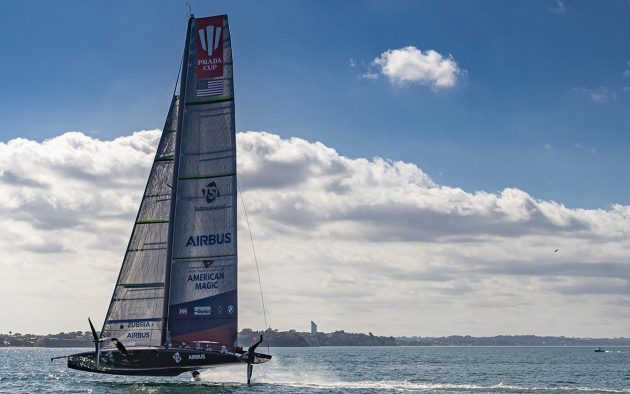
American Magic hit an impressive 53.3 knots on their final weekend of racing. Photo: COR 36/Studio Borlenghi
1 Unimaginable speed
In their final race before being knocked out of the competition , American Magic’s Patriot registered a top speed of 53.3 knots during a bear away.
Topping the 50-knot barrier used to be the preserve of extreme speed record craft and kiteboarders. A World Speed Sailing Record was set in 2009 of 51.36 knots by Alain Thebault in his early foiling trimaran, Hydroptere , and was bested in 2010 by kite boarder, Alexandre Caizergues who managed 54.10 knots.
O nly one craft has ever topped 60-knots, the asymmetric Vestas Sail Rocket , which was designed for straight line speed only and could no more get around an America’s Cup course than cross an ocean. Such records are set by sailing an average speed over the course of 500m, usually over a perfectly straight, flat course in optimum conditions.
America’s Cup class yachts, designed to sail windward/leeward courses around marks, are now hitting speeds that just over a decade ago were the preserve of specialist record attempts, while mid-race.
Perhaps even more impressive, in the right conditions when racing we have seen some boats managing 40 knots of boatspeed upwind in around 17 knots of wind. That is simply unheard of in performance terms and almost unimaginable just three or so years ago.

Photo: COR 36/Studio Borlenghi
2 A storm onboard America’s Cup boats
Related to the speeds the boats are sailing through the water, particularly upwind, is the wind speeds the sailors will feel on deck.
When sailing, the forward motion affects the wind we experience onboard, known as apparent wind. The oft’ trotted out explanation of how apparent wind works is to imagine driving your car at 50mph. Roll down the window and stick your hand out of it and there will be 50mph of wind hitting your hand from the direction your car is travelling.
Article continues below…

America’s Cup: Schedule and how to follow the racing
The teams are there, the boats are there, and finally after two months of AC75 racing in Auckland, for the…

America’s Cup Challengers: The view from Auckland
Reversing the odds over the space of four weeks where the worst performing America’s Cup team became the best and…
So when an AC75 is sailing upwind in 18 knots of breeze at a boatspeed of 40 knots, the crew on deck will be experiencing 40 knots of wind over the decks plus a percentage of the true wind speed – depending on their angle to the wind.
The AC75 crews might be sailing in only 18 knots of breeze – what would feel like a decent summer breeze on any other boat – but they experience winds of around 50 knots.
To put that into context, that is a storm force 10 on the Beaufort scale!

Once up on the foil, everything to windward of the leeward foil generates righting moment. Photo: COR 36/Studio Borlenghi
3 Righting moment changes
The single most radical development of the AC75 is to take a 75ft ‘keelboat’, but put no keel on it whatsoever.
When the America’s Cup Defender and the Challenger of Record, Emirates Team New Zealand and Luna Rossa Prada Pirelli respectively, announced the 36th America’s Cup would be sailed in 75ft monohulls, conventional wisdom had it that the boats would look something like a TP52 or a Maxi72 – both impressively high performance keelboats.
By doing away with the keel entirely, the design is now like nothing we have ever seen, particularly when it comes to how dynamic the power transition is between foiling and not foiling.
The boats are designed to foil on the leeward foil, with the windward one raised to help increase righting moment: to help balance the boat. This means that when the AC75 is not foiling they are extremely tippy – much more so than most other boats of the same size.
Essentially, when the wind catches the sails, the boat wants to fall over as there is too much sail area for the amount of weight underneath the boat – something a lead keel usually counters on a yacht or keelboat.
Once the boat is up and on the foils, however, that all changes, as everything to windward of the single foil in the water balances the sails. That means, the hull, the crew weight, the sail and rig weight, and the windward foil, all work to counter the sails.
What all this means is that the boats go from being extremely tippy, to hugely powerful in just the few seconds it takes to get up on the foil. “The [AC75s] are really very tippy pre-foiling and then they go through the transition where they will need to build significant power. Then immediately [once they lift off] you have more stability than, well, take your pick, but certainly more righting moment than something like a Volvo 70 with a big canting keel.
“That change all happens in a very short space of time,” explained Burns Fallow of North Sails, who was one of the team who developed the soft wing concept back when the concept was revealed.

With lift created to windward by the foils, it is possible that the boats can sail diagonally to windward. Photo: COR 36/Studio Borlenghi
4 America’s Cup boats may not be heading where they point
With the AC75 sailing on its foil, drag is dramatically reduced, vast amounts of power can be generated and so speeds rapidly increase. But the foils can serve another purpose too.
In order to be able to lift each foil out of the water, the foil arms must be able to be raised and lowered. Hence the foil wings, which sit at the bottom of the foil arms (and are usually a T or Y shape), do not always sit perpendicular to the water surface and the AC75s often sail with them canted over to something nearer 45º to the surface.
The further out the leeward foil arm is canted – essentially more raised – the closer the AC75 flies to surface and, crucially, the more righting moment is generated as the hull and rest of the boat gets further from the lifting surface of the foil.
There is another positive to this: as the lifting foil is angled, it produces lift to windward, which can force the boat more towards the wind than the angle it is sailing.
Due to this negative leeway (as it is known when a foil creates lift to windward) the boat can be pointing at a compass heading of say 180º but in fact will be sailing at eg 177º as the foil pushes the boat sideways and to weather, essentially sailing to windward somewhat diagonally.

5 The foils are heavy. Very heavy.
As the foils work to provide stability to the boat (when it is stationary both foils are dropped all the way down to stop it tipping over) and to provide massive amounts of righting moment, they are incredibly heavy.
A pair of foil wings and flaps (excluding the one-design foil arm which attaches them to the boat and lifts them up and down) weigh 1842kg. To put that into perspective, the entire boat itself with all equipment (but without the crew) weighs between 6508kg and 6538kg. So the foil wings at the base of the foil arms are nearly ⅓ of the total weight of the boat.
It is partly due to this that you will see some teams with bulbs on their foils. If you decide to go for a skinny foil wing (which would be low drag and so faster) then there will not be enough volume to cram sufficient material in to make the foil weigh enough. So some teams have decided to add a bulb in order to make it weigh enough but to also keep a less draggy, slimmer foil shape.
6 Sails can invert at the head

As with everything on the AC75, the mainsail is a relatively new concept. It consists of two mainsails which are attached to both corners of a D-shaped mast tube. This has the effect of creating a profile similar to a wing.
It is well established that solid wing sails are more efficient at generating power than a soft sail and for this reason solid wings were used in both the America’s Cup in 2013 and 2017. But there are drawbacks with a wing: they cannot be lowered if something goes wrong and require a significant amount of manpower and a crane to put it on or take it off a boat.
One reason a wing makes for such a powerful sail is that the shape can be manipulated from top to bottom fairly easily with the right controls. With the AC75 the designers wanted a sail that could have some of this manipulation, produce similar power but could also be dropped while out on the water. The twin skin, ‘soft wing’ is what they came up with for this class of America’s Cup boat.
In addition to the usual sail controls, within the rules, the teams are allowed to develop systems for controlling the top 2m of the mainsail and the bottom 1.5m.
What this means is that the teams are able to manipulate their mainsail in a number of different ways to develop power and control where that power is produced in the sail. But it also means that they have the ability to invert the head of the sail.
Doing this effectively means ‘tacking’ the top of the sail while the rest of the sail is in its usual shape. The advantage here is that instead of trying to tip the boat to leeward, the very top of the sail will be trying to push the boat upright and so creating even more righting moment. The disadvantage is that it would come at the cost of increased aerodynamic drag.
We know that a number of America’s Cup teams are able to do this, though whether it is effective is another question and it is very hard to spot this technique being used while the boats are racing at lightning speeds.

Photo: Emirates Team New Zealand
7 An America’s Cup boat generates lots of data
A new America’s Cup boat is a vastly complex bit of kit. Each team has incredibly powerful Computational Fluid Dynamics (CFD) software packages and simulators in order to try to understand the various gains and losses.
To make these simulators and computer projections as accurate as possible each team has been getting as much data as they can over their three year development cycle.
In the case of this America’s Cup it does seem the development process is genuinely getting closer to Formula 1 (albeit with smaller budgets than a modern F1 team has behind them).
INEOS Team UK have been able to work alongside the all powerful Mercedes F1 team (both of who are backed by INEOS) and have been open about how much this has helped their development process. They even have some Mercedes staff out with the team in Auckland assessing their data.
“It’s really similar to F1,” explains Mercedes Applied Science Principal Engineer Thomas Batch who has 11 F1 titles to his name and is with INEOS in Auckland. “Certainly in this campaign the technology is close to what we have in F1.
“In terms of raw sensors on the boat you are probably talking in the 100s but then we take that and we make that into mass channels and additional analysis with computational versions of those channels that we then analyse and get into in more detail. So you are looking at 1000s of plots that we can delve into [per race or training session].
“That level of data analysis and then feedback with the sailors is very similar to working with an [F1] driver.”
If you enjoyed this….
Yachting World is the world’s leading magazine for bluewater cruisers and offshore sailors. Every month we have inspirational adventures and practical features to help you realise your sailing dreams. Build your knowledge with a subscription delivered to your door. See our latest offers and save at least 30% off the cover price.
- Oceanis 30.1
- Oceanis 34.1
- Oceanis 37.1
- Oceanis 40.1
- Oceanis 46.1
- Oceanis 51.1
- Oceanis Yacht 54
- Oceanis Yacht 60
- FIGARO BENETEAU 3
- Heritage Sailing Yacht
- Flyer 7 SUNdeck
- Flyer 7 SPACEdeck
- Flyer 8 SUNdeck
- Flyer 8 SPACEdeck
- Flyer 9 SUNdeck
- Flyer 9 SPACEdeck
- Antares 7 Fishing
- Antares 8 Fishing
- ANTARES 11 FLY
- Gran Turismo 32
- Gran Turismo 36
- Gran Turismo 41
- Gran Turismo 45
- Swift Trawler 35
- Swift trawler 41 Sedan
- Swift trawler 41 Fly
- Swift Trawler 48
- Grand Trawler 62
- Heritage Powerboats
- Future Owners
- A REMARKABLE ANNIVERSARY
- Our History
- Our Architects and Designers
- Our philosophy
- Our Innovations
- Your way to ownership
- Event calendar
- Annapolis Sailboat Show
- Fort Lauderdale International Boat Show
- Tests and Awards

We built with you in mind for over 138 years. We’ve transformed living spaces and the list of innovations in hull design and navigation continues to grow at a rapidly increasing pace. Since 1884, BENETEAU's philosophy of building the strongest, safest, most beautiful boats on the water is alive and well. The BENETEAU family’s pride in craftsmanship and passion for performance can easily be recognized in every FIRST, FIRST SE, FIGARO, OCEANIS, and OCEANIS YACHT built today.
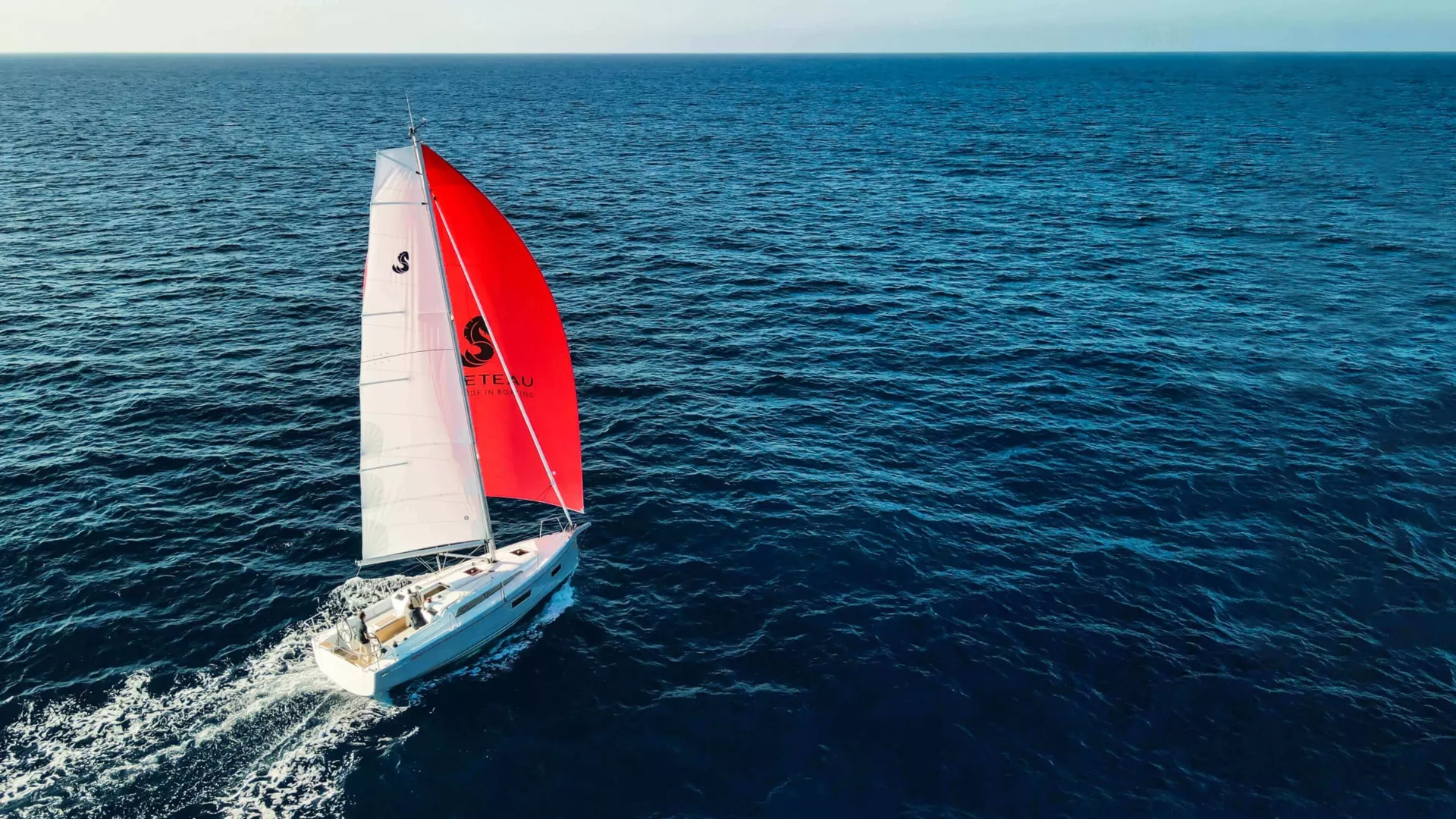
The world reference in cruising. Oceanis is our range of long-distance, blue water cruisers that for years has set the standard for sailboat design and construction, with a hull that is a marvel in hydrodynamics, Oceanis delivers superior performance while providing stability and safety while under sail. Despite her strong sea legs, she doesn’t sacrifice luxury and comfort. You can choose your layout based on different configurations below deck and also have your choice of interior finishes. Your Oceanis will be a joy to sail and be your home away from home . The Oceanis range continues to appeal to all sailors around the world.
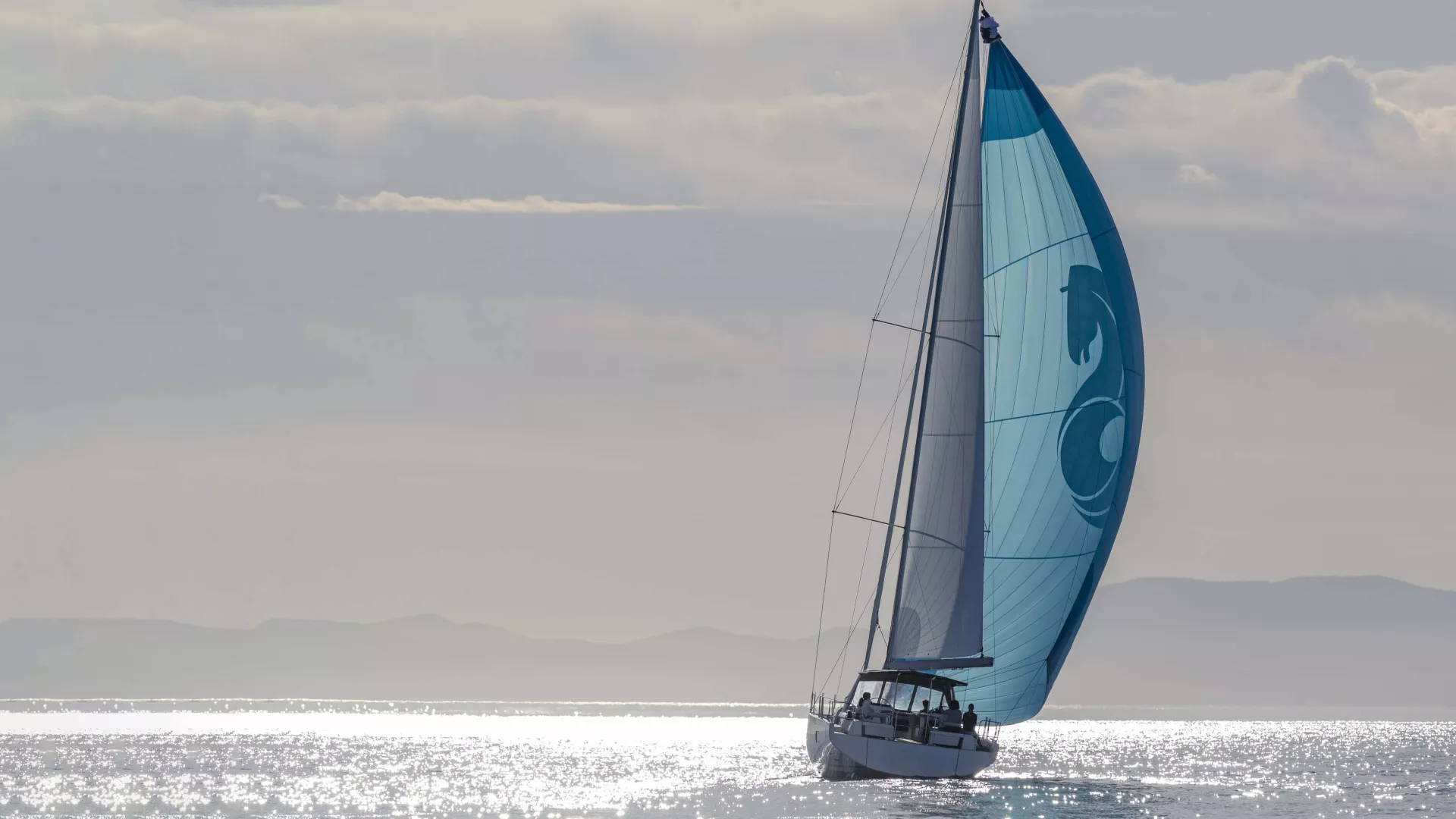
Oceanis Yacht
The Oceanis Yacht is the culmination of our Oceanis philosophy where cruising comfort, performance, and customization reign supreme. Her elegant design and luxurious interiors add a new dimension to life at sea with an enormous salon, impressive galley, spacious staterooms, and plenty of ambient light from the many large windows and skylights. Despite her lavish details, our Oceanis Yacht maneuvers as easily as a smaller yacht thanks to a perfectly centered sail plan and twin rudders. She is a yacht that represents the art of sailing at its regal best.
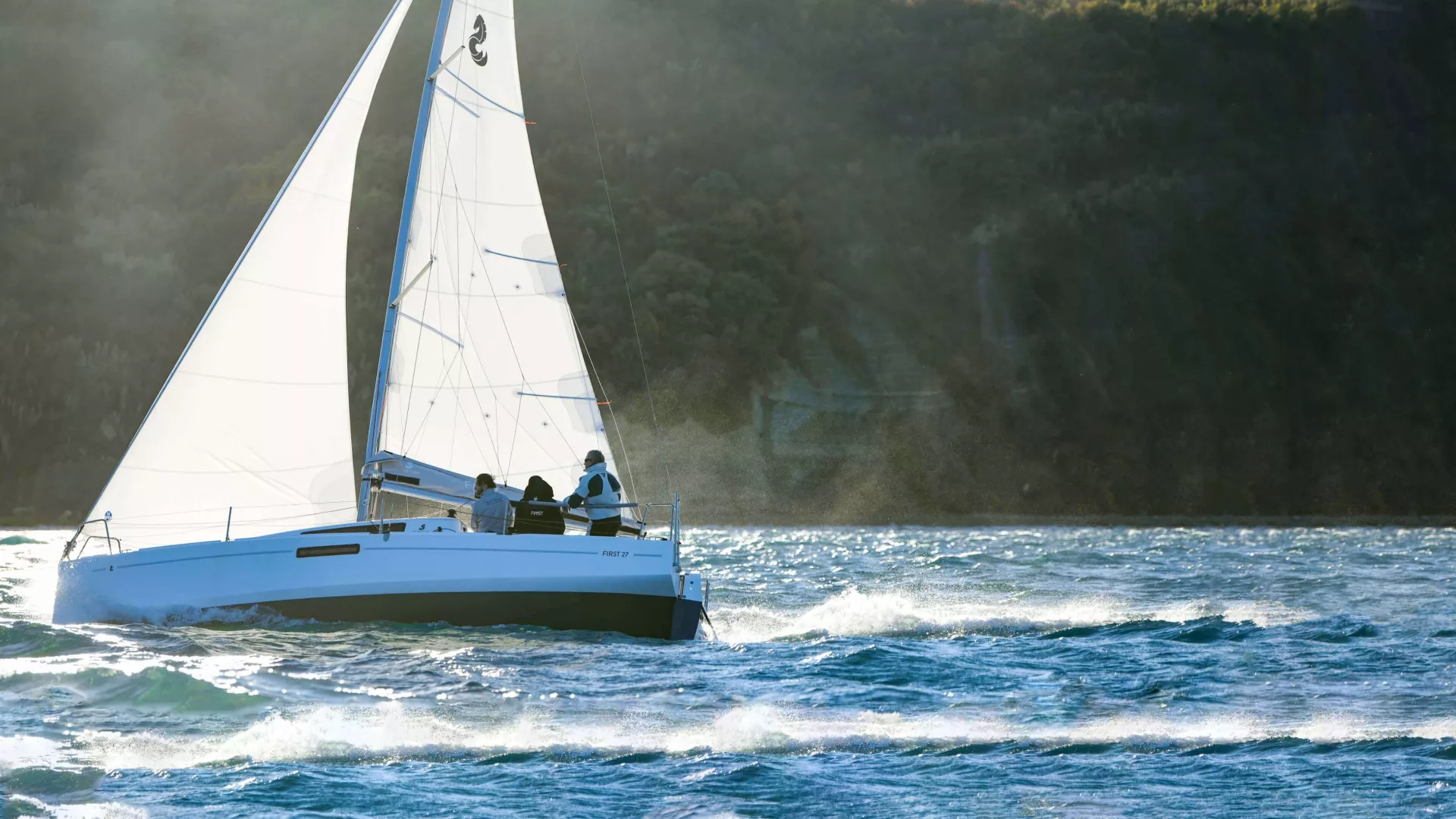
40 years of iconic brand heritage. The signature features of the FIRST range have not changed since its conception in 1977 – these boats have always been designed for sailors who enjoy club racing as much as cruising, joining them into one cohesive product line, the proverbial best of both worlds. Today, BENETEAU takes another step in this direction with the launch of the new FIRST range. These boats offer simplicity, performances, and comfortable interiors and cockpits geared towards daysailing and coastal cruising. Renewing the competition spirit of the brand, they represent a true adaptation to the needs and expectations of the widest variety of sailors.
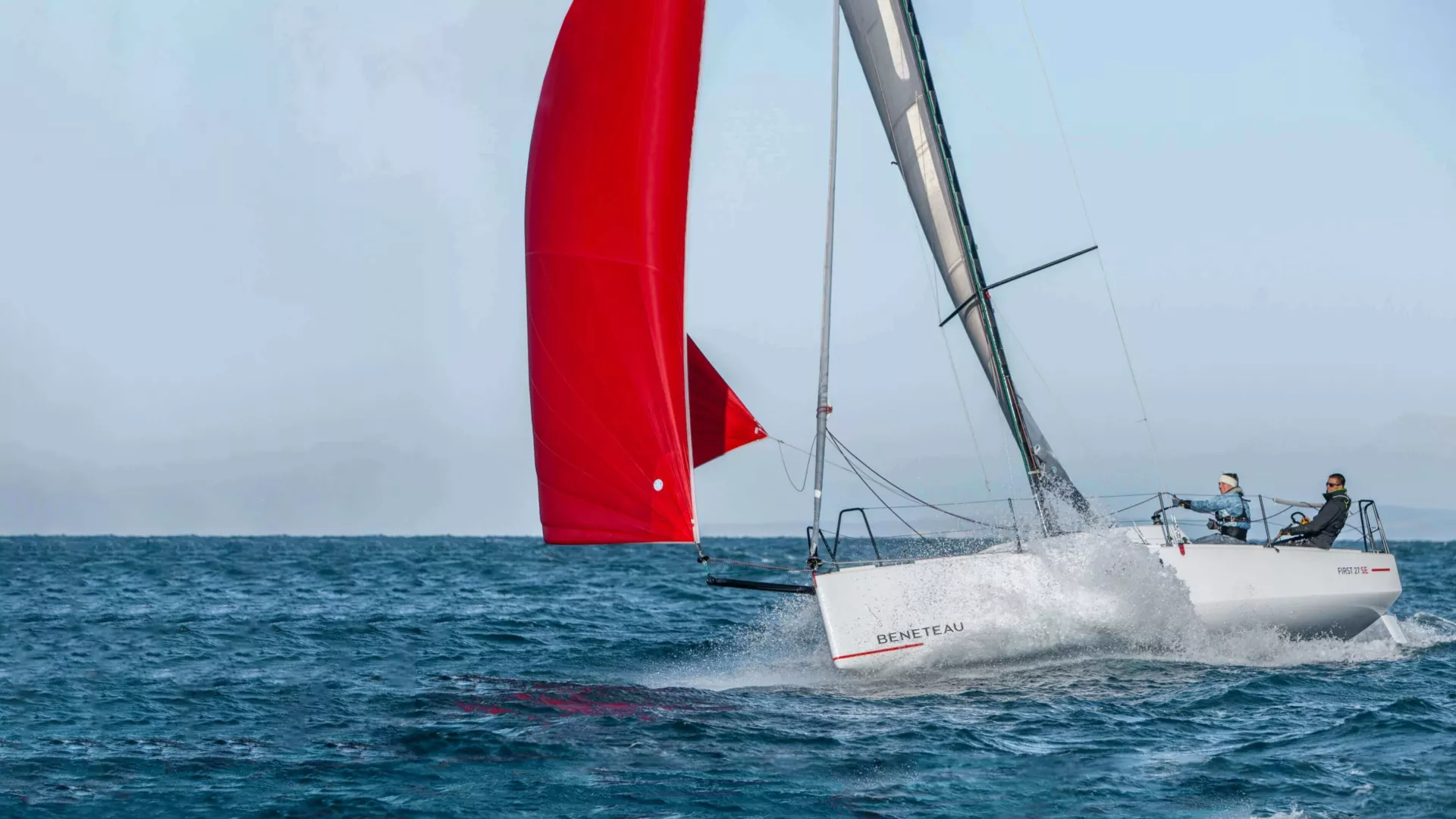
High-tech performance from the cutting edge of racing into the hands of the recreational sailors. First SE - Seascape Edition encourages and empowers sailors to expand their comfort zone by joining competitive one-design racing and adventure sailing . It grows a community of owners linked by shared values and a drive to strengthen their sailing skills. Whether owners are racing against others in one-design classes or are engaging in adventure sailing, the First SE connects them to the elements and helps them experience nature in the most authentic way. A carbon rig, laminate sails and other technological features give sailors the ultimate sailing experience, performance and control.
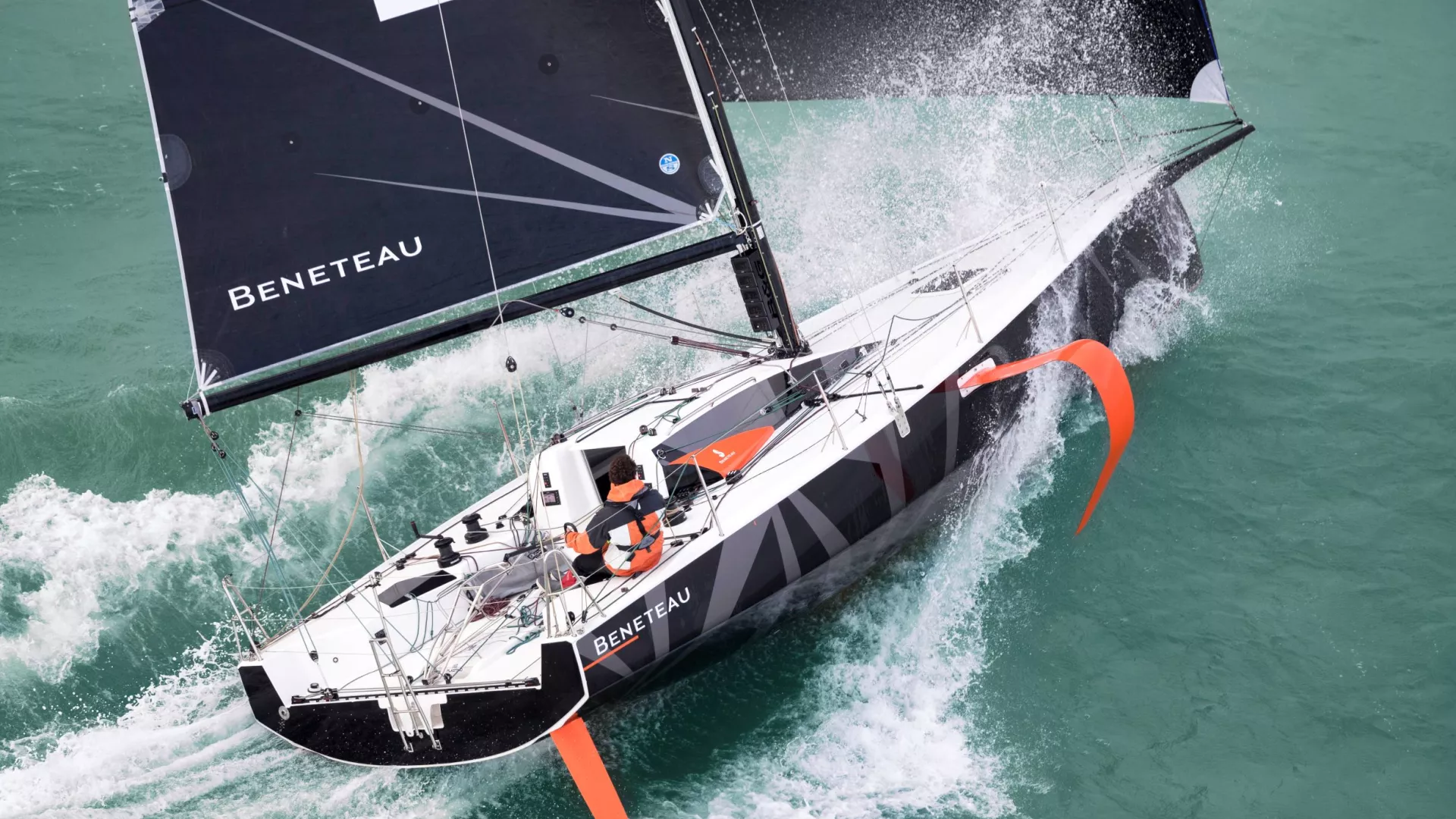
A true legend. The Figaro is an ode to excellence in offshore racing. The one-design sailing yacht was initially designed for the Solitaire du Figaro, allowing some of the greatest skippers to compete at sea on equal terms, much to their pleasure. The sailor makes the difference on a Figaro.
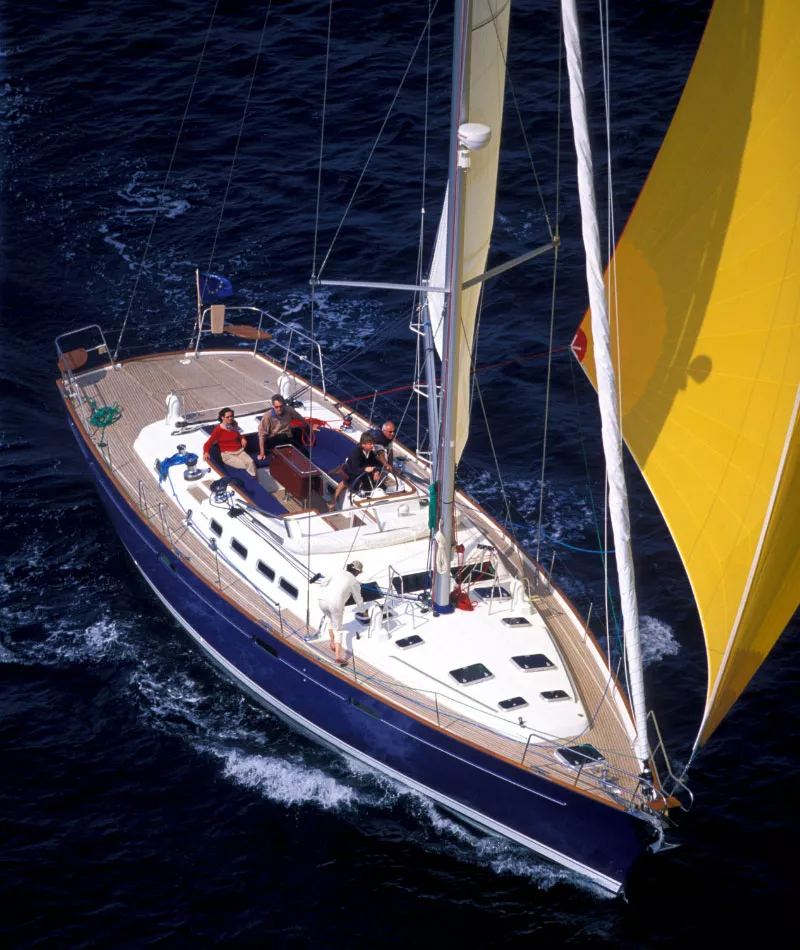
Heritage BENETEAU sailboats
Our history has been told many times in these last fifty years, but, to understand it, you need to grasp our company values, and return to its origins, since it is nothing but continuity and progression.
- Annette ROUX
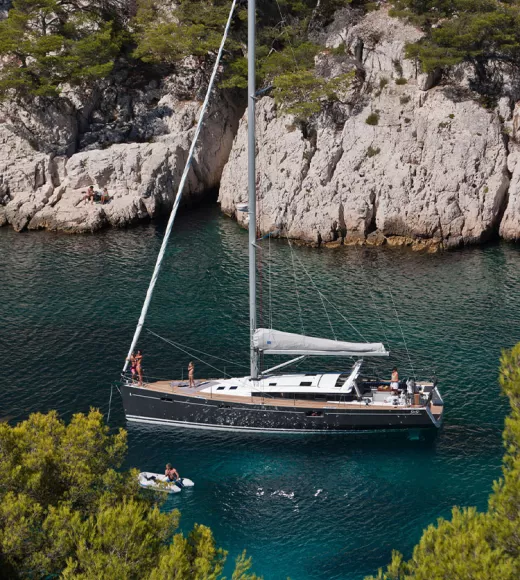
DISCOVER ALL OUR SAILING BOATS AND LUXURY YACHT RANGES
Are you looking for a sailing yacht dealer ? Leisure boating, short trips, competitive sailing, regattas – whatever type of sailing you like, BENETEAU has a wide range of sailing yachts and luxury yachts , so there’s bound to be a boat to fulfill your dreams.
SAILING YACHTS FOR ANY TYPE OF SAILING
We built our first sailboats over 138 years ago and many things have changed since then. The oak we once relied on has been replaced with strong but lightweight resin and carbon fiber. Where canvas once caught the wind, now it’s Kevlar and Vectran. We’ve transformed dark, confining salons and cabins into bright, open living spaces. And the list of innovations in hull design and navigation continues to grow at a rapidly increasing pace.
However, some things haven’t changed and never will. Benjamin BENETEAU’s philosophy of building the strongest, safest, most beautiful boats on the water is alive and well. The BENETEAU family’s pride in craftsmanship and passion for performance can easily be recognized in every FIRST, FIGARO, OCEANIS, and OCEANIS YACHT built today.
Knowing what to keep and what to change – that’s why BENETEAU continues to set the bar in sailing.
OCEANIS: THE BEST SELLER
Oceanis is our range of long-distance, blue water cruisers and for years has set the standard for sailboat design and construction. With a hull that is a marvel in hydrodynamics, Oceanis delivers superior performance while providing stability and safety under sail. Despite her strong sea legs, she doesn’t sacrifice luxury and comfort. You can choose your layout based on different configurations below deck and also have your choice of interior finishes. Your Oceanis will be a joy to sail and be your home away from home.
OCEANIS YACHTS:LUXURY YACHTS
BENETEAU is also there to help you buy a top-quality boat. The OCEANIS Yacht line delivers luxury sailing yachts that satisfy this requirement perfectly. The line comprises two luxury craft of over 50 feet, designed by renowned architects and designers.
FIRST: ICONIC PERFORMANCE SAILING
Our 7th generation of the First range offers you the experience of pure sailing joy while staying true to our standards for safety and stability. She is lightweight with a streamlined design, making her highly adaptable to whatever the wind and water have in store. The First is fast but forgiving, spicy but safe – perfect for the thrill-seeking novice or seasoned competitive sailor alike.
FIRST SE RANGE: HIGH PERFORMANCE YACHTS
First SE - Seascape Edition encourages and empowers sailors to expand their comfort zone by joining competitive one-design racing and adventure sailing. It grows a community of owners linked by shared values and a drive to strengthen their sailing skills. Whether owners are racing against others in one-design classes or are engaging in adventure sailing, the First SE connects them to the elements and helps them experience nature in the most authentic way.
FIGARO: OFFSHORE AND PROFESSIONAL RACING
A marvel in racing innovation, the Figaro BENETEAU 3 is the first production foiling one-design monohull to ever grace the seas. Designed in collaboration between BENETEAU and Van Peteghem Lauriot-Prévost (the architects of the last two Vendée Globe winners), her greatest and most visible feature is the inverted foiling system created to reduce drift and improve the righting moment without increasing movement. The Figaro BENETEAU 3’s radical design makes her the logical choice when winning isn’t everything, it’s the only thing.
SAILING YACHTS SAILING THE FIVE OCEANS
This diversity has led to the BENETEAU brand being represented on all the world’s seas. But wherever they are, BENETEAU boats are easily recognizable for their taut lines, innovative design, robustness and performance. No doubt this will continue, since BENETEAU is constantly reinventing itself to provide ever more enjoyable, high performing, safe and user-friendly recreational craft. BENETEAU achieves this by making the most of current and future innovations such as ship control, dock and go, foils, etc.
Select your area and your language
- Chinese, Simplified
AWESOME YACHTS AT AMAZING LOCATIONS
The ultimate sailing experience, with flying multihulls.
The fastest sailing yachts at the nicest locations worldwide.
Racing and Cruising.
Sales and charter.
Technical consulting, coaching and professional sailing.
Project- and team-management.
We offer the ultimative multihull sailing experience and expertise for you and your team!
Can you imagine to fly so high above the waves with such an ultrafast multihull?
Much faster than any other boat in the regatta or in a close match with other speedster.
Above and beyond. A lifetime experience.
Let´s go real speedsailing and winning together.
Welcome on board!
ROLAND GAEBLER

Olympic Medalist
10 x World Champion Tornado
15 x European Champion Tornado + Laser
6 x Winner Kieler Woche
Winner of the Volvo Champion Race
Offshore World record with the 125ft maxi catamaran "Playstation" and Steve Fossett
Also raced ORMA 60, MOD 70, Extreme40, GC32, M32, SL33, D35, M2, One Ton, Farr40, X-Yachts and many others.....
Over 80 international Championship Titles in 40 years!
Sailing professional and team coach
YES YOU CAN!!!
Sailing the ultimative. Winning the legendary races and breaking records. Check this videos..........
Roland Gaebler
Strassburger Str. 32
28211 Bremen / Germany
Mobil/WhatsApp: +49-172-4543074
Email: [email protected]
Skype: r. gaebler
www.teamgaebler.de
- Nach oben scrollen
- Other Sports
- Puget Sound
‘Everyday people’ set sail from Seattle for around-the-world race
Winds died to 2 to 3 mph from the south-southwest and Elliott Bay was glass calm. Not ideal for sailing, but not a storm either.
Those were the conditions at Seattle’s Bell Harbor Marina as 11 sailing teams from around the world set off Friday in 70-foot ocean racing yachts for the seventh leg of the Clipper Round the World Yacht Race.
The teams, each with 20 to 24 people, will traverse 7,200 miles, from Seattle to Panama and on to Washington, D.C.
Organizers say the event trains “everyday people to become ocean racers.”
Each participant must complete four weeks of intense training before taking part in one or all eight stages of the circumnavigation. As for the crew, 30% of them, who hail from 55 nations, have never been on a sailboat before readying for this race.
So far, the teams have raced over 20,000 nautical miles. The event started in Portsmouth, England, on Sept 3. After the race reaches D.C., it’s on to Scotland then back to Portsmouth on July 27, some 11 months after they departed. The full around-the-world challenge is 40,000 nautical miles.
Della Parsons, crew recruitment director for Clipper Ventures, did a presentation Wednesday in Seattle meant to inspire people to give the adventure a try. As she showed video from a previous race that included huge waves and difficult conditions, she said “You could see people’s eyes widening and thinking, ‘This is ridiculous. I could never do that.’ And then I said to them at the end of the video, ‘I know you’re thinking that but you have to remember all of the people that you’ve just seen on this video are just like you. Two years before that they were also sitting in a presentation thinking ‘this is ridiculous.’ And now look at them. They’ve just really achieved something remarkable.”
For more information check out the website .
Most Read Local Stories
- Melinda French Gates resigns from Bill & Melinda Gates Foundation
- Bob's Your Uncle: 2 Bob Fergusons withdraw from WA governor's race
- Seattle church leads counterprotest in support of Israel on UW campus VIEW
- Four things to know about Seattle's plan to explore closing schools
- Bears in the North Cascades: What you should know if you spot one WATCH
The opinions expressed in reader comments are those of the author only and do not reflect the opinions of The Seattle Times.

The global authority in superyachting
- NEWSLETTERS
- Yachts Home
- The Superyacht Directory
- Yacht Reports
- Brokerage News
- The largest yachts in the world
- The Register
- Yacht Advice
- Yacht Design
- 12m to 24m yachts
- Monaco Yacht Show
- Builder Directory
- Designer Directory
- Interior Design Directory
- Naval Architect Directory
- Yachts for sale home
- Motor yachts
- Sailing yachts
- Explorer yachts
- Classic yachts
- Sale Broker Directory
- Charter Home
- Yachts for Charter
- Charter Destinations
- Charter Broker Directory
- Destinations Home
- Mediterranean
- South Pacific
- Rest of the World
- Boat Life Home
- Owners' Experiences
- Interiors Suppliers
- Owners' Club
- Captains' Club
- BOAT Showcase
- Boat Presents
- Events Home
- World Superyacht Awards
- Superyacht Design Festival
- Design and Innovation Awards
- Young Designer of the Year Award
- Artistry and Craft Awards
- Explorer Yachts Summit
- Ocean Talks
- The Ocean Awards
- BOAT Connect
- Between the bays
- Golf Invitational
- Boat Pro Home
- Superyacht Insight
- Global Order Book
- Premium Content
- Product Features
- Testimonials
- Pricing Plan
- Tenders & Equipment

Sarissa wins Sailing Yacht of the Year at the World Superyacht Awards 2024
The 59.7-metre Royal Huisman sailing yacht Sarissa has been crowned Sailing Yacht of the Year at the 2024 edition of the World Superyacht Awards .
Like all the winners at the World Superyacht Awards , the prestigious title was chosen by an independent panel of judges and announced at the end of the awards ceremony, along with Motor Yacht of the Year winner, 66-metre Alchemy .
Sarissa was noted for her high-performance capabilities and environmental sensitivity. The 33.5-metre Baltic Yachts Zemi was vying for the title and was similarly commended for her eco credentials and telescopic lifting keel. But ultimately, Sarissa ’s cutting-edge propulsion system and state-of-the-art sails and rig clinched the deal for the judges.
The sloop represents many firsts for her builder and the sailing sector as a whole. She has a square-top mainsail that is the largest square-top sail in the world, the largest 3Di RAW sail to the highest spec ever built by North Sails and it’s the first time this type of carbon sail has been used for in-boom furling. All of this innovation, along with her clean lines, holistic design, organically flowing interior and creative layout with an abundance of exterior living spaces not usually found on a sailing boat, made Sarissa a worthy winner of Sailing Yacht of the Year.
Nominations for the World Superyacht Awards 2025 are now open. For more information, please contact the events team .
More about this yacht
Similar yachts for sale, more stories, most popular, from our partners, sponsored listings.
- The Inventory
Sail GP Team Ejected From Boat When Crew Member Pushes Wrong Button
The team was forced to withdraw from the bermuda sail grand prix after severely damaging its boat.
It’s understandable to assume that yacht racing is solely the purview of ascot-wearing socialites. However, hydrofoiling catamarans used in the highest level of international competition aren’t toys. SailGP yachts are capable of reaching 60 miles per hour. Higher speeds also mean bigger incidents, and Team USA found out the hard way last Friday during practice for the Bermuda Sail Grand Prix.
Related Content

The Team USA yacht was rounding the first mark when the top of the wingsail inverted, pitching the catamaran over. Almost the entire crew fell from their starboard stations onto the wing, displaying exactly why they all have to wear helmets while racing. SailGP stated that the incident was caused by user error. The user in question was the team’s wing trimmer Victor Diaz de Leon. He said, “While operating the wing, I chose the wrong function on my control panel, which caused our boat to flip. It was very scary and I’m thankful all my teammates are safe.” Data showed he hit that button seven times.
While his teammates escaped the crash unscathed, the damage to the yacht was so significant that Team USA withdrew from the Bermuda Sail Grand Prix before the competition officially began. While visually dramatic, SailGP’s most dangerous crashes are when two or more boats collide. It’s never fun to have carbon-fiber craft with exposed cockpits bashing into each other at nearly highway speeds. In some ways, I’d rather crash a Formula 1 car.

American Magic sails new 'Patriot' AC75 for the first time ahead of 37th America's Cup
T uesday in Barcelona, Spain, American Magic took its first spin in the boat it hopes to sail to victory in the 37th America's Cup.
The 75-foot boat took to the waters with its mainsail sporting a large "Pensacola, Florida" logo that it will carry for the entire international race series this fall.
Before sailing, the New York Yacht Club Vice Commodore Clare Harrington christened the new AC75 as "Patriot," the second boat sailed by American Magic to carry that name.
The previous Patriot was also an AC75 and sailed many times in Pensacola as the team gathered data and trained for the version unveiled this week. The previous Patriot had its last sail i n the waters of Pensacola Bay in February 2023 .
American Magic lease approved: Find out what's included
Much like the rules of Formula 1 racing, the sailboat is a 75-foot foiling monohull that meets the AC75 design rules laid out by the America's Cup. Still, within those rules, the American Magic team has made its own designs to give it an edge in the racing competition set to take place this fall.
"The New York Yacht Club has never wavered from its core purpose of ensuring international competition at the highest level of skill and performance," Harrington said at the Patriot's christening. "That is our tradition. However, the launch of Patriot also signifies innovation, blending two distinct elements: tradition and innovation. And so I bring to American Magic the heartfelt wishes of all 3,400 plus members of the New York Yacht Club for your success in the upcoming competition, maintaining the club's tradition through your inspired innovation."
The team said that more than 108,000 design hours and 65,000 construction hours went into making the Patriot.
"We followed our own design path with Patriot as we pushed the limits of the AC75 rule while tailoring for the Barcelona venue," American Magic Design Coordinator Scott Ferguson said in a team press release.
The team had the boat foiling after running some initial tests on it, before having to bring it back to the dock as the weather forecast in Barcelona called for thunderstorms.
"As far as first days go inside the American Magic program, really, this was probably our best day," Terry Hutchinson, president of sailing operations at American Magic, told an America's Cup camera crew after the sail.
The Patriot was built and designed at the American Magic's previous headquarters in Rhode Island, but the boat will return to Pensacola after the America's Cup this fall. The next AC 75 for the 38th America's Cup is planned to be designed and built at the team's new headquarters at the Port of Pensacola.
The 37th America's Cup will hold its third preliminary regatta this August in Barcelona as a final full-scale practice race.
Then the Louis Vuitton Cup will take place in August and September 2024, where the teams will compete for the right to race against the defending team, Emirates New Zealand, in the actual 37th America's Cup in October 2024.
This article originally appeared on Pensacola News Journal: American Magic sails new 'Patriot' AC75 for the first time ahead of 37th America's Cup


IMAGES
VIDEO
COMMENTS
Racer sailing vessels pricing. Racer sailing vessels for sale on YachtWorld are offered at a variety of prices from $7,374 on the relatively more affordable end all the way up to $2,667,999 for the rarest of yachts. Find Sail Racer boats for sale in your area & across the world on YachtWorld. Offering the best selection of boats to choose from.
Find used boats and used yachts for sale or for charter. Becoming one of the largest dedicated website for Performance Yachts and Racers In the market. Search our extensive database from around the world and make contact to one of our seven sales offices in Europe.
A Racing Sailing Yacht, also called a cruiser/racer, is considered a hybrid vessel because it can accommodate overnight cruising but is trimmed with the equipment for competitive racing. Usually 35-50 feet in length, it's relatively light in weight. The deck is easy to get around when either cruising or racing.
The Official Website of SailGP - get the latest sail racing news, calendar, results, rankings and schedule. ... Flying boats. Iconic cities. World-class athletes. Adrenaline-fueled races, legendary global locations, rival national teams and record-breaking speeds. SailGP is the most exciting racing on water - Powered By Nature.
The Dehler 30 One Design is selected Sailing World Magazine's Best Offshore Racer in its Boat of the Year competition. The 30-foot pure raceboat is designed for racing with fewer crewmembers ...
Yacht racing is a sailing sport involving sailing yachts and larger sailboats, as distinguished from dinghy racing, which involves open boats. It is composed of multiple yachts, in direct competition, racing around a course marked by buoys or other fixed navigational devices or racing longer distances across open water from point-to-point. It ...
Swan 65 test: The triumphant return of a true sailing icon. Read more. Yacht racing, sailing news, events and blogs from Yachting World, covering the world's biggest yacht races.
Race Boats for Sale, News & Advice. With over 25 years of experience specialising in performance sail boats ranging from 25 to 100ft, Ancasta Race Boats will be able to guide you through the sale or purchase of any racing yacht. We are the market leaders with an in depth knowledge of the various rating rules operating around the globe, as well ...
Racing Sailboats. Activities: Racing. Length Range: 16 - 100 ft. Average price: $224,000. 2-3 cabins. Few boats are built with as single-minded a purpose as racing sailboats. As you'd expect they're built to sail fast—as fast as possible—to the exclusion of almost all other factors. There are, however, many different classes of racing ...
The SailGP scoring system is simple; points are awarded for races and events, and are added up to determine the three boat line-up of the winner-takes-all Season Grand Final. At each Sail Grand Prix, there are six fleet races before the winner-takes-all Final determines the event champion. The event leaderboard totals the points teams have ...
Beneteau First. J/Boats. Reichel Pugh. Jeanneau. X-Yachts. Nautor's Swan. Grand Soleil. Browse our selection of listed racing sailboats for sale. Filter by make, year, price, and more with our yacht search tool.
With over 150+ yachts and counting, Racing-Yachts.com is the becoming one of the largest dedicated website for Performance Yachts and Racers In the market. I understand. This website uses cookies. This allows us to offer you the necessary functionalities and also improve your user experience. If you visit our website, you agree to the cookie ...
There are many types of racing sailboats that range from one-man dinghies all the way to 100-foot yachts. Some racing sailboats are classified as keel boats, multi-hull, and even a tower ship. These boats are built primarily for speed, so comfort is usually an afterthought depending on the brand. For racing sailboats, each one is going to fit ...
One-Design Wingfoil Racing Takes Off. Sailing World is your go-to site and magazine for the best sailboat reviews, sail racing news, regatta schedules, sailing gear reviews and more.
The market for racing sailing yachts includes a range of sizes and classes, from small one-design dinghies to large, ocean-going boats. Buyers interested in purchasing a racing yacht will typically look for models that offer a balance of speed and control, as well as high-quality equipment and rigging. Whether for personal enjoyment or ...
In SailGP, five-member crews representing six countries race identical F50 foiling catamarans in the world's most famous harbours. Complex control systems an...
Sailing used to be considered as a rather sedate pastime. But in the past few years, the world of yacht racing has been revolutionised by the arrival of hydrofoil-supported catamarans, known as ...
The America's Cup boats currently racing in the Prada Cup, the AC75s, are arguably the most radical boat the America's Cup has ever seen. ... Related to the speeds the boats are sailing ...
These sailboats have a minimum total sail area of 155 square feet, a maximum total sail area of 1,453 square feet and an average of 770 square feet. Boat Trader currently has 88 racer sailboats for sale, including 27 new vessels and 61 used and custom yachts listed by both individuals and professional dealerships mainly in United States.
Sailboats. We built with you in mind for over 138 years. We've transformed living spaces and the list of innovations in hull design and navigation continues to grow at a rapidly increasing pace. Since 1884, BENETEAU's philosophy of building the strongest, safest, most beautiful boats on the water is alive and well.
6 x Winner Kieler Woche. Winner of the Volvo Champion Race. Offshore World record with the 125ft maxi catamaran "Playstation" and Steve Fossett. Also raced ORMA 60, MOD 70, Extreme40, GC32, M32, SL33, D35, M2, One Ton, Farr40, X-Yachts and many others..... Over 80 international Championship Titles in 40 years! Sailing professional and team coach.
San Diego Yacht Club's Invitational Masters Regatta is a gathering of the sailign's wise men and women. ... One of the greatest attributes about racing sailboats is the opportunity to learn and ...
Shifting gears from the tracks, Ferrari has set its sights on taming the seas. Partnering with sailing veteran Giovanni Soldini as team principal, the iconic Italian marque recently announced its entry into the world of high-performance sailing, marking a bold expansion beyond the high-speed tracks it's known for. While luxury carmakers venturing into other spheres isn't unheard of ...
Those were the conditions at Seattle's Bell Harbor Marina as 11 sailing teams from around the world set off Friday in 70-foot ocean racing yachts for the seventh leg of the Clipper Round the ...
The 59.7-metre Royal Huisman sailing yacht Sarissa has been crowned Sailing Yacht of the Year at the 2024 edition of the World Superyacht Awards.. Like all the winners at the World Superyacht Awards, the prestigious title was chosen by an independent panel of judges and announced at the end of the awards ceremony, along with Motor Yacht of the Year winner, 66-metre Alchemy.
A sailboat refers to any class and subclass of boat that is designed with one or more masts and rigging system as the main source of propulsion. Sailboats are available in a variety of models and rigs, including racing boats, sloops, schooners, catamarans, trimarans, sailing cruisers, and others. Some of the first sailboats on record date back ...
The USA SailGP Team's boat was damaged after flipping on its side during a training race in Bermuda. 00:42 - Source: CNN. Stories worth watching 16 videos. Video Ad Feedback ...
It's understandable to assume that yacht racing is solely the purview of ascot-wearing socialites. However, hydrofoiling catamarans used in the highest level of international competition aren ...
Tuesday in Barcelona, Spain, American Magic took its first spin in the boat it hopes to sail to victory in the 37th America's Cup. The 75-foot boat took to the waters with its mainsail sporting a ...